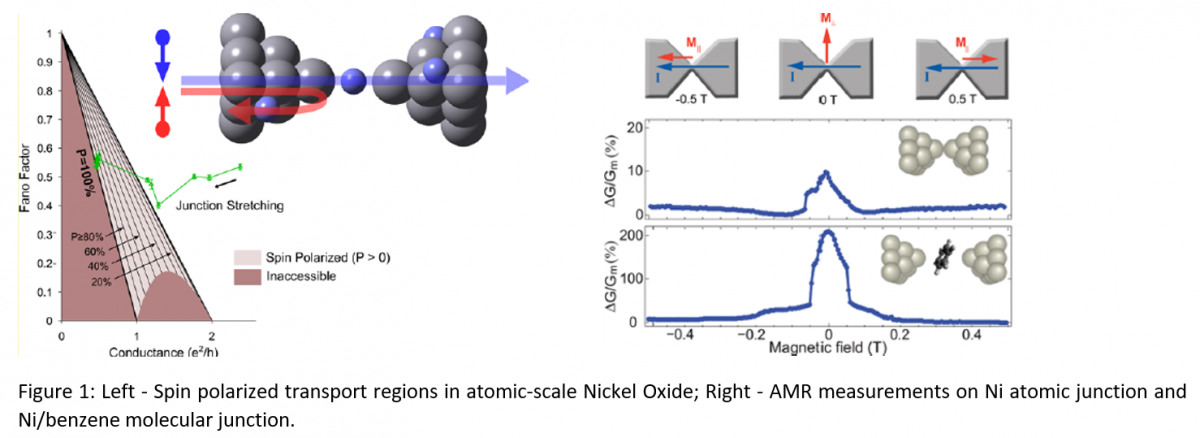Spintronics has a large impact on daily life, being the backbone of computing and electronic applications. The reduction in the size of spintronic elements is of central importance for efficient information processing. At the atomic scale, electronic transport is very sensitive to the fine details of the electronic orbital structure. Using this sensitivity, we provide methodologies that control and explore atomic-scale charge, transmit up to fully spin-polarized current by systematic orbital modifications and, in addition, amplify magneto-resistive effects of nanoscale magnetic elements while retaining a large signal, without the need for rare metals or complicated device structure.
While conventional electronics is based on the charge of electrons, exploiting the additional spin degree of freedom offers advantages for electronics and computing applications. The most central requirement from a spin-based device is the ability to generate highly spin-polarized currents of a single spin type. Highly spin-polarized currents at the nanoscale are extremely important for modern electronics and quantum control. However, devices that can filter electronic currents with significant spin polarization become increasingly challenging and are yet to be realized in the nanoscale. An additional challenge in modern electronics is to minimize the size of memory bits while maintaining a large signal for accurate reading of the stored information. Current memory storage devices that used read heads based on the anisotropic magneto-resistance (AMR) effect, following by the giant magneto-resistance (GMR) and tunneling magneto-resistance (TMR) effects have reached a maximum 20% change in resistance for junctions made of relatively simple ferromagnetic materials. Further increase in the sensitivity of such memory elements requires the use of sophisticated production techniques, the use of expansive materials, the use of multi-layered architectures, and, in some cases, the use of complicated electronics to amplify the low signal. An interesting approach that does not require a complicated architecture and can overcome these limitations is to scale down to nano-size in order to provide a large magneto-resistance effect.
Prof. Oren Tal and his group developed novel methods that generate spin polarization currents at nanoscale enabling spintronic miniaturization, spin filtering, and enhanced magnetoresistance.
When current passes through an atomic-sized constriction, quantum confinement dictates that electronic transport is governed by the fine details of the local electronic structure. Suitable atomistic conditions can also affect the balance between spin-up and spin-down currents. Prof. Tal and his team took advantage of this sensitivity to efficiently manipulate spin-dependent transport by modifying the structure and composition of an atomic-scale conductor. They found that the formation of a nickel oxide (NiO) atomic junction between two nickel electrodes leads to highly efficient spin filtering that allows only one spin-type to flow through the constriction. This is explained in view of the orbital hybridization between low-coordinated Ni and O atoms, resulting in the emergence of local half-metallicity.
In addition, there is a special bonding properties of conjugated oligoacene molecules to ferromagnetic surfaces which the team used for enhanced AMR effect. The adsorption process involves hybridization between the delocalized π orbitals of the molecule and the highly-spin polarized d orbitals of the metal electrodes. This hybridization results in preferential conductance through the spin polarized orbitals, leading to at least one order of magnitude enhancement in magnetoresistance.

- Atomic scale conductor that generates electronic spin currents or injects highly spin-polarized currents.
- The ideal structure for spin-valve - the basic device for spintronics.
- Atomic-scale magnetic bits for data storage - as the magnetization of the nickel-oxide atomic chains can be tuned, different schemes such as heat pulse, magnetostriction, and mechanical deformation can be used for writing and erasing bits.
- AMR enhancement for memory applications such as nanoscale spin-valve memory elements or larger sensitive yet elementary memory devices.
- Gains up to 100% spin-polarized current at the nanoscale.
- Spin filtering can occur at the scale of an atom.
- Controls spin transport by low-coordination chemistry.
- Enhances and tunes magnetoresistance using molecules as conductors.
- Enables significant increase in anisotropic magnetoresistance (AMR)
Prof. Tal and his team showed that nickel-oxide (NiO) atomic junctions made by oxidation of an atomic bridge between two nickel wires exhibit up to 100% spin-polarized conductance. The extremely high spin polarization was found to exist without the need of applying external magnetic fields. The team found that the degree of spin polarization can be tuned effectively by mechanical strain to yield a remarkable atomic-scale conductor with one dominant spin-polarized conduction channel. The team demonstrated, additionally, that spin filtering can be significantly enhanced by local chemical modifications at the single-atom level and that a minor change in the local atomic structure (i.e. the incorporation of oxygen between the Ni electrodes) can dramatically alter spin-transport properties1.
Furthermore, Prof. Tal and his team demonstrated that adding a single-molecule junctions based on nickel electrodes and benzene molecules can yield a significant anisotropic magnetoresistance (AMR) of up to ∼200%2. It was shown that magnetoresistance can be mechanically tuned by changing the distance between the electrodes and that there is an optimal molecular orientation with respect to the ferromagnetic metal electrodes for maximum AMR due to efficient spin-selective orbital hybridization. This emphasizes the important role of geometrical considerations in determining the spin transport properties of metal−molecule interfaces.
Controlling electronic spin transport at the atomic scale has a huge market potential which can include:
- New material properties - (e.g., evolution from bulk insulator to magnetic conductor at the nanoscale).
- New physical phenomena - (e.g., high and tunable magneto-resistance effects).
- Novel design principles for nanoscale electronic elements - (e.g., spin-polarized current by selective orbital hybridization).
- Vardimon, R., Klionsky, M., & Tal, O. (2015). Indication of complete spin filtering in atomic-scale nickel oxide. Nano letters, 15(6), 3894-3898.
- Rakhmilevitch, D., Sarkar, S., Bitton, O., Kronik, L., & Tal, O. (2016). Enhanced magnetoresistance in molecular junctions by geometrical optimization of spin-selective orbital hybridization. Nano letters, 16(3), 1741-1745.


